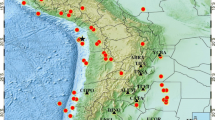Abstract
It is necessary to model and analyze the ionospheric effects due to a direct relationship between Global Positioning System (GPS) applications and changes in the ionosphere. In order to monitor these changes, the ionosphere can be represented by the vertical total electron content (VTEC) which can be used to analyze ionospheric conditions from a variety of stations. In this study, 21 stations were used to carry out analysis and estimation of VTEC. Three days during a geomagnetic storm, namely, 7, 8, and 9 January 2005, are chosen for investigation. In addition, the de-correlation time of the VTEC was estimated to define ionospheric variations in time using autocorrelation analysis. The de-correlation time of the ionosphere is based on correlation times estimated by using autocorrelation functions. From the high-latitude stations, the mean of the correlation times decreased from 8 to 6 epochs during a storm. In this time period, it was found from the station results that the ionosphere was more affected at the high-latitude than at the mid-latitude region.
Similar content being viewed by others
References
Cander, L.R., and L. Ciraolo (2010), Ionospheric Total Electron Content and critical frequencies over Europe at solar minimum, Acta Geophys. 58, 3, 468–490, DOI: 10.2478/s11600-009-0061-2.
Dach, R., U. Hugentobler, P. Fridez, and M. Meindl (eds.) (2007), Bernese GPS Software Version 5.0, Astronomical Institute, University of Bern.
Grejner-Brzezinska, D.A., N. Arslan, P. Wielgosz, and C.-K. Hong (2009), Network calibration for unfavorable reference-rover geometry in network-based RTK: Ohio CORS case study, J. Surv. Engrg. 135, 3, 90–100, DOI: 10.1061/(ASCE)0733-9453(2009)135:3(90).
Haro Barbás, B.F. de, V.H. Ríos, A. Pérez Gómez, and M. Santillán (2002), Variations of total electron content during a magnetic storm, Geofís. Int. 41, 1, 49–55.
Hernandez-Pajares, M., J.M. Juan, J. Sanz, R. Orus, and M. Garcia-Fernandez (2004), GPS Ionospheric Monitoring, Presentation at the Colloquium on Atmospheric Remote Sensing using Global Positioning System, 20 June–2 July 2004, Boulder, CO.
Hernández-Pajares, M., J.M. Juan, J. Sanz, R. Orus, A. Garcia-Rigo, J. Feltens, A. Komjathy, S.C. Schaer, and A. Krankowski (2009), The IGS VTEC maps: a reliable source of ionospheric information since 1998, J. Geod. 83, 3–4, 263–275, DOI: 10.1007/s00190-008-0266-1.
Komjathy, A., B.D. Wilson, B. Iijima, and A.J. Mannucci (2006), Daily JPL processing of 1000+ ground-based GPS receivers to estimate ınterfrequency biases and other practical applications. In: T. Springer, G. Gendt, and J.M. Dow (eds.), Proc. IGS Workshop 2006 “The International GNSS Service (IGS): Perspectives and Visions for 2010 and Beyond”, Darmstadt, Germany, 8–12 May 2006 (abstract and presentation).
Krankowski, A., I.I. Shagimuratov, L.W. Baran, and I.I. Ephishov (2005), Study of TEC fluctuations in Antarctic ionosphere during storm using GPS observations, Acta Geophys. Pol. 53, 2, 205–218.
Liu, Z., S. Skone, Y. Gao, and A. Komjathy (2005), Ionospheric modeling using GPS data, GPS Solut. 9, 1, 63–66, DOI: 10.1007/s10291-004-0129-z.
Orús, R., M. Hernández-Pajares, J.M. Juan, J. Sanz, and M. García-Fernández (2002), Performance of different TEC models to provide GPS ionospheric corrections, J. Atmos. Sol.-Terr. Phys. 64, 18, 2055–2062, DOI: 10.1016/S1364-6826(02)00224-9.
Paris, J., and M. Menvielle (2004), The ISGI WWW homepage, 35th COSPAR Scientific Assembly, held 18–25 July 2004, in Paris, France, Raport 2909.
Rama Rao, P.V.S., S. Gopi Krishna, K. Niranjan, and D.S.V.V.D. Prasad (2006), Temporal and spatial variations in TEC using simultaneous measurements from the Indian GPS network of receivers during the low solar activity period of 2004–2005, Ann. Geophys. 24, 3279–3292, DOI: 10.5194/angeo-24-3279-2006.
Rideout, W., and A. Coster (2006), Automated GPS processing for global total electron content data, GPS Solut. 10, 3, 219–228, DOI: 10.1007/s10291-006-0029-5.
Sardón, E., and N. Zarraoa (1997), Estimation of total electron content using GPS data: How stable are the differential satellite and receiver instrumental biases?, Radio Sci. 32, 5, 1899–1910, DOI: 10.1029/97RS01457.
Stanisławska, I., and A. Belehaki (2009), Space weather observational activities and data management in Europe, Acta Geophys. 57, 1, 236–244, DOI: 10.2478/s11600-008-0076-0.
Tsagouri, I., B. Zolesi, L.R. Cander, and A. Belehaki (2010), DIAS effective sunspot number as an indicator of the ionospheric activity level over Europe, Acta Geophys. 58, 3, 491–512, DOI: 10.2478/s11600-009-0045-2.
Wild, U. (1994), Ionosphere and Geodetic Satellite Systems: Permanent GPS Tracking Data for Modelling and Monitoring, Geod.-Geophys. Arb. Schweiz. 48, Schweizerischer Geodätischen Kommission, Zurich.
Wu, S., K. Zhang, Y. Yuan, and F. Wu (2006), Spatio-temporal characteristics of the ionospheric TEC variation for GPSnet-based real-time positioning in Victoria, J. Glob. Position. Syst. 5, 1–2, 52–57, DOI: 10.5081/jgps.5.1.52.
Yousuf, R., and S. Skone (2005), WAAS performance evaluation under increased ionospheric activity. In: Proc. 18th Inter. Technical Meeting of the Satellite Division of the Institute of Navigation (ION GNSS — 2005), 13–16 September, Long Beach, CA.
Yue, X., W. Wan, L. Liu, and T. Mao (2007), Statistical analysis on spatial correlation of ionospheric day-to-day variability by using GPS and Incoherent Scatter Radar observations, Ann. Geophys. 25, 8, 1815–1825, DOI: 10.5194/angeo-25-1815-2007.
Author information
Authors and Affiliations
Corresponding author
Rights and permissions
About this article
Cite this article
Arslan, N. Correlation analysis of vertical total electron content. Acta Geophys. 59, 377–397 (2011). https://doi.org/10.2478/s11600-010-0042-5
Received:
Revised:
Accepted:
Published:
Issue Date:
DOI: https://doi.org/10.2478/s11600-010-0042-5




